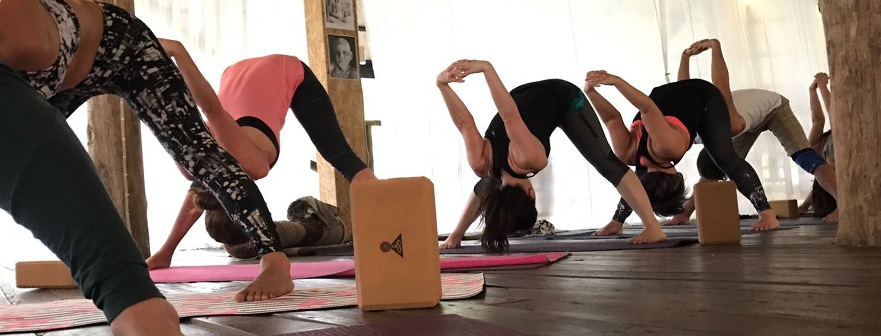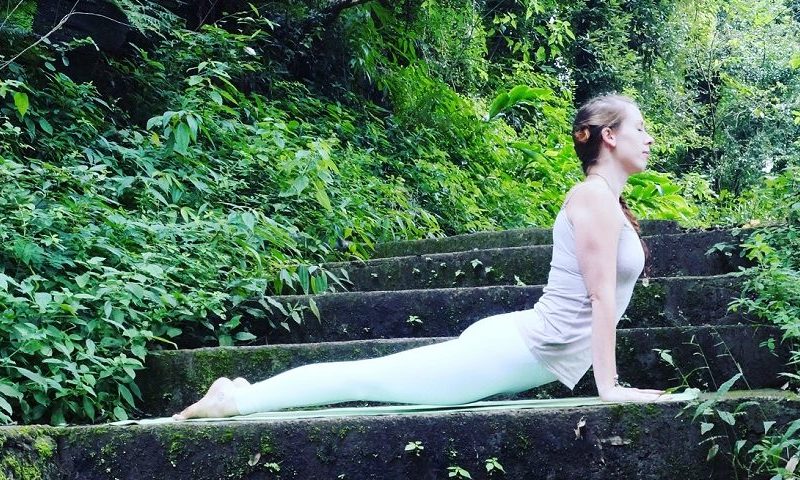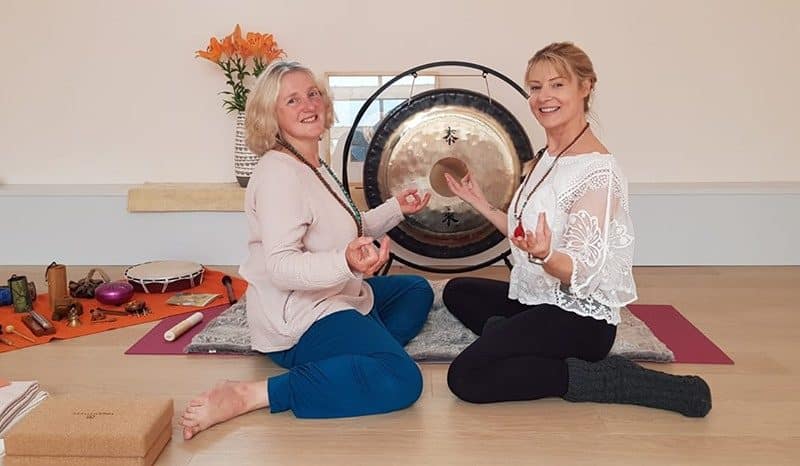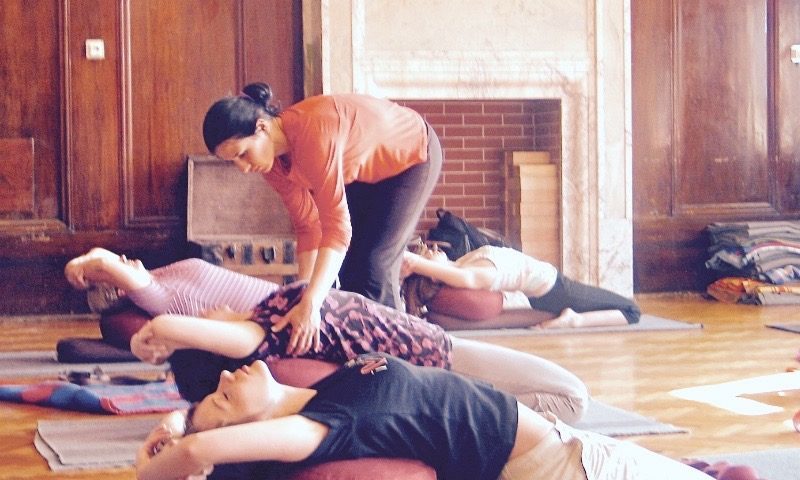No more prescribed drugs due to Yin yoga and self-myofascial release
Come off the medication I hear you say? Let me explain how to improve your health with yin yoga and Self- Myofascial Release…
From an early age I suffered from lower back pain, dating back to my early years running for school and county in 800m and cross country races. I remember lying on my belly with a bag of frozen peas on my back at around 14 or 15 years of age. Over the years, chiropractors have said that I have a slight lordotic arch (an excessive inward curvature of the lower back, sometimes referred to as “swayback”) Unfortunately, then I didn't know how to improve my health with yin yoga and Self- Myofascial Release and avoid pain.
I am a teacher of yoga and Pilates, up until last year; I also taught group exercise classes on and off for over twenty years. During the first ten years of my career, you could say I battered my body! With over twenty classes a week including group cycle, body pump, ‘Legs, Bums & Tums’ classes – these had all taken their toll – especially the constant repetitive motion of bending forwards.
As I got older, I worked abroad teaching and running boot camps. My back pain got worse and worse. Moving back to the UK, I took some time out from teaching and settled in Reading with my fur babies! I was STILL in daily pain and used to wake up every morning feeling like Robocop. Is this what I had to look forward to in my 40s and beyond? Daily medication including prescribed anti-inflammatory tablets, muscle relaxants and even anti-depressants that would tell my brain that I wasn’t in pain! I even gave up all group exercise classes and only taught yoga and Pilates. I was in a complete quandary as to what I should do next?
In 2017, I returned to teaching and the pain worsened with all the classes I was teaching. Was I to consider giving up the vocation I was truly passionate about?
Whilst teaching at a studio, I came across a wonderful teacher – Jason Searing. He taught about Yin yoga and fascia. He explained the need for Yin in our very Yang lives and how to improve your health with yin yoga and Self- Myofascial Release. I realized then that my body and mind were in a complete battle with each other.
I was hooked and left intrigued … wanting to know more about Yin yoga and Self- Myofascial Release (SMR). Through all my anatomy courses over the years, I had never come across this term. I started practicing the poses but I was in so much pain that I went back to the doctors. This visit brought to light that there was something seriously wrong with my lower back; following an MRI scan, the results showed SIGNIFICANT DEGENERATIVE DISC DISORDER at L/5 –S1 without any neural compression.
During late 2017 and early 2018, I trained as a Yin yoga teacher with Sarah Lo in London. I also eventually took over the teaching of restorative yoga class from Jason and my learning of the science literally took over my life.
Stages of yin yoga
In Yin yoga, there are stages to coming into a pose and holding from 2 -5 minutes and rebounding. Here’s what I discovered with practice, teaching and research of Yin yoga and fascia.
Stage1: Finding your first edge.
That first point of resistance and from that mild edge of sensation observe what is being felt in the joints and muscles. Sensations should never be more than a dull ache and should not gravitate towards anything sharp, stabbing or burning pains or pins and needles. With the aid of blocks, bolsters, straps, and blankets to help, as I call it – your body’s scaffolding.
Stage2: Relax the target area with the muscles relatively relaxed.
You will feel the stress transfer to the deeper connective tissues. You may feel multiple target areas within one pose. This is normal and may change during the hold. For my first eight months of Yin practice, the Sphinx, Seal, and Saddle poses (see pictures below) were extremely challenging and painful!
Stage 3: Find stillness.
Make sure to change the angle to accommodate for any release. Let gravity take you or back away from sensations that become too intense. Tune in and listen to your inner teacher.
Yin yoga is slow paced and the practice is very focussed around the breath. It brings a more mindful practice, bringing the mind to the present moment (which in turn helps us to balance the scales of our very yang lives where we are constantly doing, doing, doing and pushing ourselves, worrying about the past and the future).
Stage 4: Come out of the pose with care, super slow – like a snail.
This allows the body to rebound.
Stage 5: Rest in a comfortable, neutral position and bring all your focus to back to the breath.
By early 2018 I had completed my Yin yoga training and again, the term fascia came up. I started researching this and came across another term … SMR (Self Myofascial Release).
What is fascia?
Fascia is the spider web of soft tissue that holds the whole body together. It holds and wraps our bones, organs, and muscles together. It protects every part of the body. Fascia does not want to be changed by any external forces. It is made up of so many channels, which run deep into the body right down to the cellular level. (Think of a bag in a bag in a bag). Fascia has sensors which constantly ‘talk’ to the brain, relaying information, more so than our eyes and tongue. It constantly checks any external changes. Our fascia is constantly creating change from the inside out. Fascia is composed of 65% water so keeping hydrated is necessary to enable the fascial sheets to glide easily. (Think of a spider’s web first thing on a dewy morning, sparkling with moisture). Movement, massage, SMR, good diet, and sleep are all important key factors to keeping our fascia healthy.
SMR (Self-Myofascial Release)
“SMR helps to correct imbalances and pain patterns via trigger points in the body”. Tennis ball and foam rolling (body rolling) is vital to keep our fascia healthy, less stiff and more flexible. “To not wear out the lower back we must open into the upper back and shoulders.” By releasing these knots and tight spots via trigger points with the use of the ball or the roller we release the pain in the shoulders. “Shoulders are how we manipulate the world. To open up the spine we have to get through the hips and shoulders” – Thomas Myer
To conclude I am now no longer taking daily prescribed medication. I practice SMR 2-3 times a week, get a monthly deep tissue massage, and undertake regular Yin yoga classes and fingers crossed my life has become pain-free. My mobility in my spine has vastly improved. I have noticed that the poses I couldn’t do or were very painful; I am now able to do with ease and much less pain. What’s changed? Have my connective tissues become more lubricated or healed? Is my fascia healthier? Is it my Yin yoga? Is it the SMR? or it is both, the yin yoga Self- Myofascial Release? I have a feeling that all these combined factors have changed my life!
To learn more about Yin yoga and Self- Myofascial Release join me in my weekly classes or monthly workshops. For details, events, prices, class availability or one of my yoga retreats in dreamy destinations..
Thanks to the following resources and courses for all my research used in this blog.
Brightening our inner skies yin and yoga – Norman Blair
The complete guide to yin yoga – Bernie Clark
Sarah Lo yin yoga teacher manual – www.sarahlo.co.uk
Insight Yoga – Sarah Powers
Jo Phee myofascial release and yin yoga – Omstars.com
The yin yoga Kit- Biff Mithoefer
Role of fascia in movement and function – University of California – YouTube
Thomas Myer – YouTube videos
Joe Benett – YouTube
Appi training small balls – London
AMAC Dynamic Training – Foam Rollers Course



